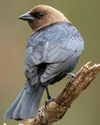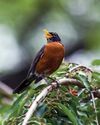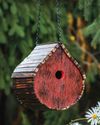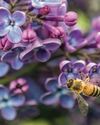Fuel late-season hummingbirds with these fall-blooming nectar picks.

Hummingbird habits in autumn aren’t what they used to be—and that could be a good thing if you'd like to see more of the speedy little fliers whizzing around your backyard later in the season.
“Things have shifted,” says John Rowden, director of community conservation at the National Audubon Society. Ruby-throated hummingbirds, the only species found in most of the eastern half of the country, used to depart colder regions in September. Now some of them are lingering into October, with sightings in November and even December, far outside their usual wintering range.
Also on the rise across much of the country are fall sightings of western hummingbirds like the coppery rufous, calliope, Anna’s and others.
Scientists can’t say for sure what is causing the recent shift. But John notes that late fall hummingbirds “are actually spending a fair bit of time at feeders, guarding a feeder as a very valuable resource.”
While sugar-water feeders provide an easy feast, hummingbirds often take breaks from a feeder to visit nearby flowers or snap up tiny insects. And if a feisty hummer declares that a feeder is all mine, late-blooming plants give others a chance to eat.
So when summer's most sweltering heat is behind you, it’s important to have planted food sources that will provide snacks through the early fall rush and keep thriving, even after frost.
PLANT A FALL FEAST
This story is from the June/July 2019 edition of Birds & Blooms.
Start your 7-day Magzter GOLD free trial to access thousands of curated premium stories, and 8,500+ magazines and newspapers.
Already a subscriber ? Sign In
This story is from the June/July 2019 edition of Birds & Blooms.
Start your 7-day Magzter GOLD free trial to access thousands of curated premium stories, and 8,500+ magazines and newspapers.
Already a subscriber? Sign In

Clever Cowbirds
Learn more about these birds that are infamous for letting others raise their young

Ask the Experts
Pros offer spring plant care tips and tough IDs

Rustic diy Birdhouse
Whether you're hardcore handy or an everyonce-in-a-while crafty person, you probably have a small pile of scrap wood handy. Grab your tools and turn your extra materials into any house wren's dream nest box.

THE LATEST IN Lilacs
Learn about updated varieties of this timeless classic and how to take care of them

Meet the ORIOLES
GET TO KNOW eight TYPES SEEN THROUGHOUT THE U.S. AND WHAT MAKES EACH ONE STAND OUT

CBD FOR YOUR PAIN
Everyone feels the hurt as you age, but CBD can help you deal with it

Welcome, New Blooms
Update your yard with 2024's freshest florals

Western Blues
Beckon these regional bluebirds to your yard with nest boxes and mealworms

Incredible Eggs
Fun facts about these tough yet fragile wonders

Life Well Lived
Surprising facts about bird life spans